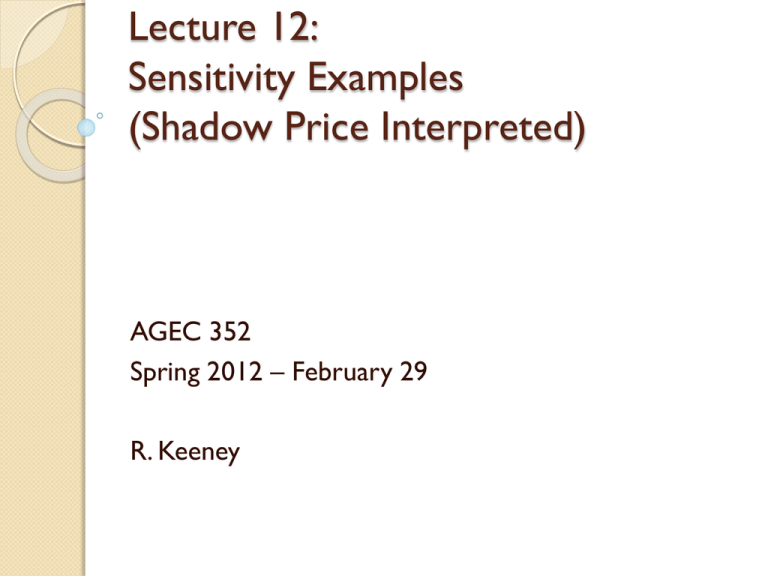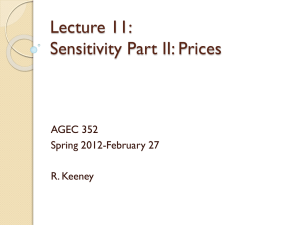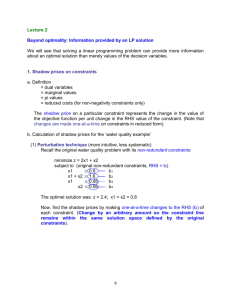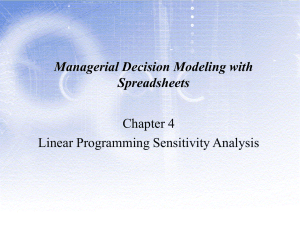Lecture 1: Basics of Math and Economics
advertisement

Lecture 12: Sensitivity Examples (Shadow Price Interpreted) AGEC 352 Spring 2012 – February 29 R. Keeney Shadow Price signs Signs on shadow prices differ whether the inequality constraint is ≤ or ≥. They also differ for maximization and minimization problems. Maximization Minimization ≤ Positive Negative ≥ Negative Positive Less than (<=) case A boundary that is <= (upper bound) We use +1 definition of shadow price ◦ The +1 will always ‘relax’ the upper bound A decision maker facing a less restrictive choice set ◦ Can be better off (binding constraint) ◦ Can be unaffected (slack constraint) Better off depends on max vs. min Great than (>=) case A boundary that is >= (lower bound) We use +1 definition of shadow price ◦ The +1 will always ‘tighten’ a lower bound A decision maker facing a more restrictive choice set ◦ Can be worse off (binding constraint) ◦ Can be unaffected (slack constraint) Better off depends on max vs. min Example (Upper/Max) Upper bound ◦ Maximization ◦ Land available to plant Shadow price = the change in returns generated by a +1 to the land constraint Shadow price = Maximum rent that can be paid Use extra profits from additional resources to acquire the resource Example (Upper/Min) Upper bound Minimization ◦ Fertilizer mix phosphate limit ◦ Shadow price = the change in costs from a 1 unit increase in the phos limit ◦ Shadow price = discount the mixer could offer to the buyer to expand the phos limit Pass some of cost savings to buyer Example (Lower/Max) Lower bound Maximization ◦ Every 10 acres of corn planted requires 1 acre left fallow (set aside) Shadow price = change in profits from increasing set-aside by 1 Shadow price = payment farmer must receive to participate Example (Lower/Min) Lower bound Minimization ◦ Calcium requirement in a daily diet Shadow price = change in cost of requiring an extra unit of calcium Shadow price = maximum price that can be paid per unit of non-food calcium supplement Lab Assignment Problem 4 Fertilizers (see lab 5 for fertilizer info) ◦ Different compositions of nitrogen, potash, and phosphate ◦ Meet an order (at minimum cost) by mixing the four fertilizers that has: Exactly 1000 units of fertilizer At least 20% (by weight) nitrogen At least 30% (by weight) potash At most 8% (by weight) phosphate Shadow Prices in Fert. Problem Fertilizer Component LHS RHS Shadow Price Nitrogen 201.3 >= 200 0.00 Potash 300.0 >= 300 10.00 Phosphate 80.0 <= 80 -14.00 Total Weight 1000 =1000 11.70 Interpretation of Potash Potash constraint Required to have a minimum amount of potash in the fertilizer mix Increasing the RHS of the potash constraint makes the problem more restrictive, higher percentage of potash required Shadow price is positive because costs will increase with the increase of RHS Interpret this as the amount we would be willing to pay to avoid having the RHS increase Also, the discount we could offer for a mix that had 0.1% less potash content Interpretation Phosphate Phosphate constraint Upper limit on the phosphate content Increasing the RHS of the phosphate constraint makes the problem less restrictive, higher percentage of phosphate allowed Shadow price is negative because costs will decrease with the increase of RHS Interpret this as the amount we would be willing to pay to relax the RHS by one unit Also, the markup we should charge if someone required 0.1% less phosphate in their fertilizer mix Interpretation in general Always should be in context of the problem ◦ Signs are actually trivial if you understand the problem (better off/worse off) ◦ Does an increase in the RHS improve or worsen the objective? If it improves, then we know the willingness to pay for increasing the RHS If it worsens, then we know the willingness to pay to avoid having the RHS increase Advanced Analysis: Which constraint is the most costly? Recall the cereal problem from lecture ◦ Two cereals mixed to meet minimum requirements on thiamine, niacin, and calcium Nutritional Requirement LHS RHS Shadow Price Thiamine 1 >= 1 14.44 Niacin 5 >= 5 2.36 Calories 722.2 >= 500 0.00 Rather than comparing units, we want to compare % of RHS 1 mg of thiamine and 1 mg of niacin are not directly comparable % increases in the RHS of constraints are however Nutritional Requirement Thiamine Niacin Calories RHS 1 5 500 1% increase 0.01 Shadow Price 14.44 SP * 1% increase 0.14 0.05 5 2.36 0 0.12 0.00 Ranking the constraints Thiamine was the most costly constraint to meet We would have judged this the same just comparing shadow prices, but that could be misleading Similar to elasticity interpretations Elasticity of demand for food versus cars Requires that you understand the problem and interpretation to make the comparisons Fertilizer Problem Fert Component N K P total RHS 200 300 80 1000 Shadow Price 0 10 -14 11.7 1 pct 2 3 0.8 10 Value of 1Pct Increase 0 30 -11.2 117 Consider ◦ Is total comparable to others? ◦ How to deal with positive vs negative shadow prices? Compare relaxations of constraints… Common percentage and direction (of objective variable) Fert Component N K P total RHS 200 300 80 1000 Shadow Price 0 10 -14 11.7 1 pct 2 3 0.8 10 Cost saving, 1% change in K ◦ Total cost reduces $30.00 Cost saving, 1% change in P ◦ Total cost reduces by $11.20 Value of 1Pct Increase 0 30 -11.2 117 Planting Problem Land LHS Rowcrop Land LHS Wht Allot LHS Jan-Apr Labor LHS May-Aug Labor LHS Sep-Dec Labor LHS 500 400 120 1600 2000 1600 1% S Price SP * 1% 5 13.75 68.75 4 0 0 1.2 12 14.4 16 6.25 100 20 0 0 16 0 0 Shadow price for land is 2X labor ◦ 1 unit of land is usually worth more than a unit of labor Compare them as 1% increase in our resource base (labor > land > allot)






![ShadowPowerp[1]](http://s2.studylib.net/store/data/005442171_1-9acfb2dbdb399f93aedc919e80cb90fa-300x300.png)



